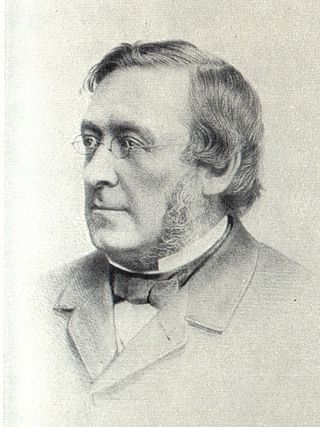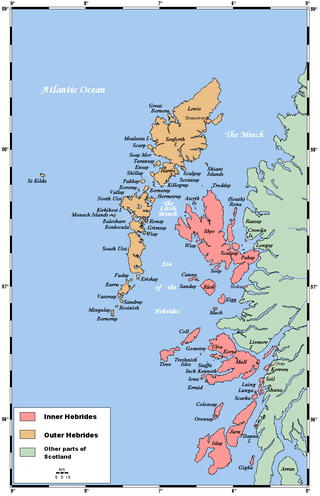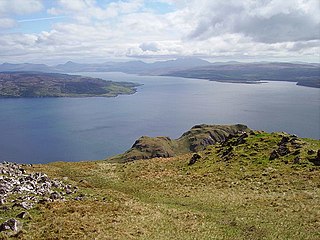
David Stevenson MICE FRSE FRSSA was a Scottish lighthouse designer, who designed over 30 lighthouses in and around Scotland, and helped continue the dynasty of lighthouse engineering founded by his father.

The Mull of Galloway is the southernmost point of Scotland. It is situated in Wigtownshire, Dumfries and Galloway, at the end of the Rhins of Galloway peninsula.

The Minch is a strait in north-west Scotland which separates the mainland from Lewis and Harris in the Outer Hebrides. It was known as Skotlandsfjörð in Old Norse.

Cape Wrath Lighthouse at Cape Wrath was built in 1828 by Robert Stevenson and was manned until 1998, when it was converted to automatic operation by the Northern Lighthouse Board. It is located at the most North-Westerly point on the British mainland, in the traditional county of Sutherland within Highland Region. Durness is the closest village, 10 miles (16 km) to the south-east with Inverness around 120 miles (190 km) to the south.

Covesea Skerries Lighthouse, originally belonging to the Northern Lighthouse Board (NLB), is built on top of a small headland on the south coast of the Moray Firth at Covesea, near Lossiemouth, Moray, Scotland.

Barns Ness Lighthouse is 3.1 miles (5 km) from Dunbar and was constructed by the engineers and brothers David A. Stevenson and Charles Alexander Stevenson, cousins of the novelist Robert Louis Stevenson, between 1899 and 1901. Taking approximately 2½ years to construct, it was constructed from stone quarried from Craigree and Barnton. In 1976 it was described as a tall tower, slightly tapered with a circular section having a circular lantern which has triangular panes and a domed roof. The keepers' cottages were, as is typical, one floored, flat roofed buildings which were coated with harling but had their quoins exposed. The lintel above the door to the lighthouse is dated 1901. Within the compound of the lighthouse there was also a sundial and a flagpole.

Little Ross is a 29-acre (12-hectare) island with a lighthouse on the Solway Coast south of the town of Kirkcudbright in Galloway, Scotland. It is next to Meikle Ross on the mainland, which is a headland, and there are two small rocks off it, Sugarloaf and Fox Craig. The island can only be accessed by private boat or helicopter. Its sole electricity is supplied by solar panels and a small wind turbine. The island is well known for the murder of one of its lighthouse keepers, Hugh Clark.

The Sound of Mull is a sound between the Inner Hebridean island of Mull and mainland Scotland. It forms part of the Atlantic Ocean.

Rua Reidh Lighthouse stands close to the entrance to Loch Ewe in Wester Ross, Scotland.

Ardnamurchan Lighthouse is a listed 19th century lighthouse, located on Ardnamurchan Point in Lochaber part of the Highland council area of Scotland. The lighthouse with its 36-metre-tall (118 ft), pink granite tower was completed in 1849 to a design by Alan Stevenson. It is the only lighthouse in the UK built in the Egyptian style. Mains electricity was installed in 1976, the light was automated in 1988 and is now operated remotely by the Northern Lighthouse Board from Edinburgh.

Neist Point Lighthouse is a lighthouse located on Neist Point on the Isle of Skye in Scotland. It was designed by David Alan Stevenson and was first lit on 1 November 1909. An aerial cableway is used to take supplies to the lighthouse and cottages.

The Cantick Head Lighthouse is an active 19th century lighthouse on the Scottish island of South Walls in the Orkney Islands. It is located at the end of Cantick Head, a long peninsula on the south-eastern coast of South Walls that overlooks the Pentland Firth and the Sound of Hoxa, which forms the southern entry to the natural harbour of Scapa Flow.

The Noss Head Lighthouse is an active 19th-century lighthouse near Wick in Caithness in the Highland council area of Scotland. It is located at the end of Noss Head, a peninsula on the north-west coast of Caithness that overlooks Sinclairs Bay, three miles north-east of Wick. It is notable as being the first lighthouse that was built with a diagonally-paned lantern room.

The Ruvaal, Rhuvaal, or Rubh'a' Mhàil Lighthouse is a listed 19th-century lighthouse located at the north-eastern end of the island of Islay, in the Inner Hebrides off the west coast of Scotland. The active lighthouse marks the northern approaches to the Sound of Islay, a narrow channel separating Islay from the adjacent island of Jura, and is one of the seven lighthouses operated by the Northern Lighthouse Board, which act as maritime aids to navigation on and around Islay.

Inninmore Bay is a small shallow coastal embayment, on a chord of 1.74 miles, on a 215° orientation, in the Morvern peninsula in Lochaber, in the western coast of Scotland, and is some three miles east-south-east of the entrance to Loch Aline.

Girdle Ness Lighthouse is situated near Torry Battery on the Girdle Ness peninsula just south of the entrance to Aberdeen's harbour, in Scotland. It is an active light, managed by the Northern Lighthouse Board.

The Mull of Kintyre Lighthouse on Mull of Kintyre was the second lighthouse commissioned in Scotland by the Commissioners of the Northern Lights. It was designed and built by Thomas Smith and completed in 1788. Smith had previously designed the light at Kinnaird Head, but Mull of Kintyre was a far more substantial project, in a far more remote location.


















